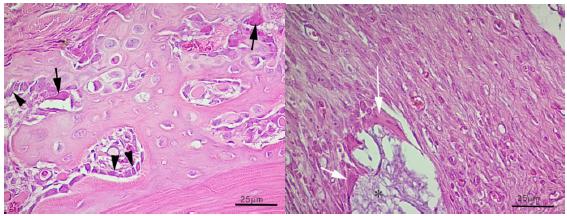Abstract
Purpose:
To analyze the therapeutic potentials of different hydroxyapatites used for the correction of bone defects in rats.
Methods:
Forty rats, male, albino wistar, were distributed in 4 groups. They were submitted to a 3.5 mm defect in tibia. They received low purity hydroxyapatite, Strontium hydroxyapatite and hydroxyapatite doped with gallium, having a seven day evaluation time. Histopathology slides were stained with hematoxylin-eosin, for morphological evaluation. Were analyzed inflammatory processes, necrosis, presence of osteoclasts and osteoblasts, presence of the material, presence of white cells, neovascularization and bone neoformation.
Results:
It was observed that the groups HAPSr and HAPGa, presented better results of trabecular bone, hyaline cartilage and bone marrow more organized.
Conclusion:
There was improvement in the repair of the bone defect produced, showing that these hydroxyapatites are effective osteoinductive, osteoconductive, osteintegrant agents and have biocompatibility, and may be indicated for use in defect repairs.
Key words:
Biocompatible Materials; Durapatite; Strontium; Bone Remodeling; Rats


